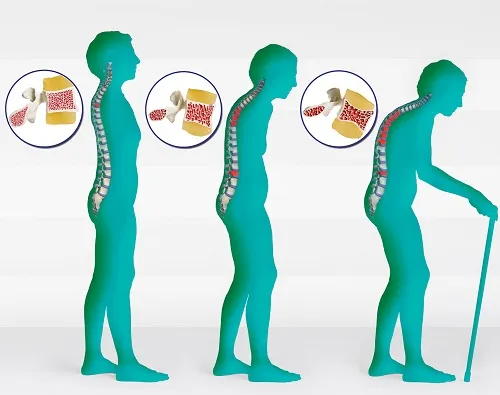“Osteo” means bone and “porosis” means porous. Osteoporotic bone has less bone mass per unit volume.
Post-menopausal women are most commonly affected although men beyond 70 years of age are also affected less commonly. People with severe liver or kidney function impairment or those with endocrine problems are at risk of developing osteoporosis. Smoking can accelerate osteoporosis also.
Bone looses calcium at an accelerated pace after menopause in women due to less oestrogen levels in the body. The bone gradually becomes more and more porous and eventually can fracture even under routine normal loads.


Most commonly, fractures due to osteoporosis occur in the spine, hips or near the wrists. Vertebral or hip fractures can make them bed ridden for a while and tilt the balance towards worsening of general health of the person. After one osteoporotic fracture, the risk of another fracture increases by at least 5 times. Recurrent multiple vertebral compression fractures lead to a forward bend / curve in the spine, reducing the overall height. The spinal muscles are at a disadvantage due the deformity in the spine and can lead to significant back pain.
The forward stoop can lead to a significant restriction of lung capacity and restrict the capacity of the stomach as the sternum digs into the upper abdomen. These factors lead to reduced oral intake as well as reduced endurance of the person to physical activity. Both these, in turn can lead to worsening of general condition and depression. This is the beginning of the downward spiral of health that can eventually result in mortality. It is an established fact that those with osteoporotic fractures have higher mortality than those without fractures. So, prevention of an osteoporotic fracture is of utmost importance in old age. Prevention starts with early detection of the condition.
Early detection of osteoporosis needs screening tests to assess the bone density. DEXA scan or quantitative CT scans are used to diagnose osteoporosis and estimate the severity. Women who are over 5 years after menopause should undergo a DEXA scan to assess the bone density. There are tools to assess the future risk of fracture in any individual based on certain clinical parameters.
Post-menopausal women need additional calcium and vitamin D supplements to meet the daily recommended allowances. Diet rich in calcium and vitamin D, including milk products, eggs, fish, nuts and fruits like oranges are recommended. Those with a low density score need additional medication to improve the bone density and reduce the risk of fracture. Bisphosphonates are the usual first line medications used to increase the bone density. Other options like teriparatide or denosumab injections are chosen based on individual clinical scenario.
If you liked the article, please share it and subscribe to my future articles on spine problems. Thank you.!

With years of experience in spine surgery, Dr Phani Kiran S, Senior Consultant Spine Surgeon will assess you and suggest the treatment option that is right for you.
We at Medspine clinics, understand the importance of educating all our patients about the spinal problems and the most effective ways to take care of their spine.
The Ortho Clinic: Monday, Wednesday, Friday, Saturday.
Ojas Health: Tuesday, Thursday
© Copyright 2024 MedSpine. All Rights Reserved. Build with 🤍 by Digital GYB
WhatsApp us